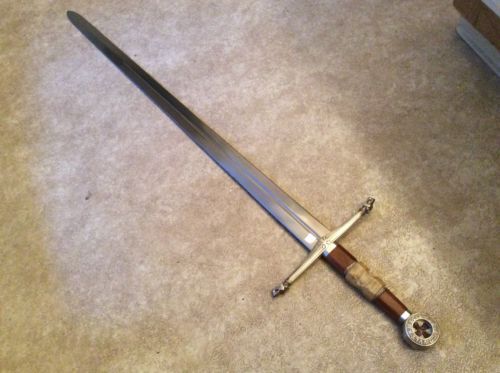A scimitar is a type of backsword or sabre. It originated in Southwest Asia. Many long swords today have scimitar blades or pommels. Both ancient and medieval warriors used the scimitar, and they were popular throughout the Middle Ages and into the 19th century. Listed below are some of the most common types of scimitars, and let’s explore each of these types in more detail.
A scimitar is a curved sword that is light in weight with a single sharp edge. Its name comes from a Persian word, shamshir, which means “lion’s claw.” Many other names also know the Scimitar, including saif, kilij, and sahib. Its name was likely influenced by the Ottoman Empire’s swords and medieval Persians and Turks.
Regardless of the name, scimitars are an outgrowth of the battle axe. Their curved design and distinctive appearance result from Turkic warriors from Central Asia. Scimitars were widespread in the Middle East and Eastern Europe during the Ottoman period. Earlier, Arab and Persian Swords had straight blades. But after the Mongol invasions in the 13th century, Turkic cavalry adopted scimitars, which spread throughout Europe and Eastern Asia.
A scimitar knife is similar to a butcher’s knife. It has a thick, curved blade and is useful for various tasks when dressing meat. The most common uses include cutting small pieces of meat and extracting the meat from bones. However, these knives have many other uses as well. They are sometimes used interchangeably with the butcher knife or a breaking knife. Butchers and knife enthusiasts can benefit from this unique type of knife.
A scimitar is a short, curved sword. The term is derived from Middle Eastern and Asian cultures, and its blade shape and distinctive blade have made it a symbol of Arab culture, which is why it can be found on the flag of Saudi Arabia. Scimitar is possibly derived from the Persian word shafsher, meaning “lion’s claw.”
If the symptoms are severe, surgery may be necessary. Most scimitar syndrome surgeries will result in no further symptoms, but some people may experience narrowing of their rerouted pulmonary vein, which may require further treatment. Adults with scimitar syndrome may not show any symptoms, but many may suffer from other heart problems. Surgery is necessary if these problems are affecting the quality of life. Some of these adults may also need special tests to determine if the pressure in their lung arteries is elevated. Furthermore, you can purchase Samurai Sword and other types of swords from Battling Blades in affordable prices.
The scimitar has many cultural and historical meanings. It is used as a weapon in battle and can symbolize either the East or West. It is also used in heraldry, including in ancient Scandinavia and Russia. In Finland, the scimitar is represented by a lion trampled by a lion. Throughout history, the scimitar has been used as a symbol of war, and it has been associated with many different cultures and religions.
A diagnosis of scimitar syndrome should be made as soon as possible. This rare congenital heart defect affects the pulmonary artery and the right lung. Symptoms may be subtle in infants and young children, but surgery is usually necessary within the first two months of life. The vein may need additional surgery to help narrow it. Adults with scimitar syndrome often lead normal lives without surgery and average life expectancy.
The scimitar’s blade is rectangular in shape and blunt, and its blade length is around ninety centimeters, but it can be longswords or shorter sword. Modern scimitars are lighter than their ancient cousins but can weigh up to five hundred grams. They are typically made from fine-tempered steel and have a circular handguard. They can be up to 110 cm in length and weigh as much as 500 grams.




